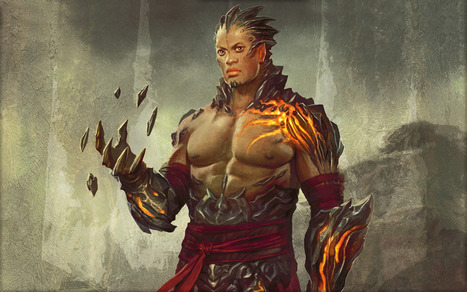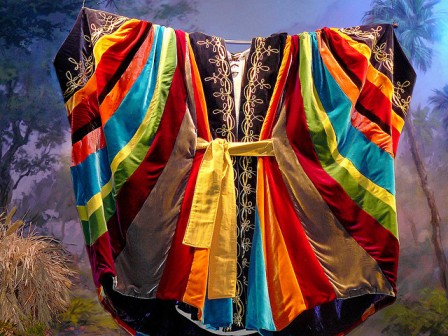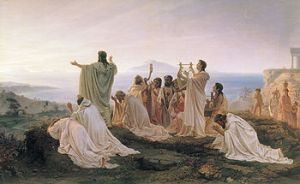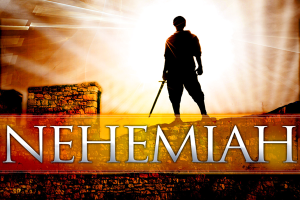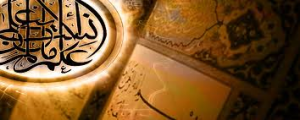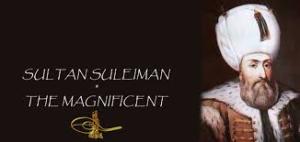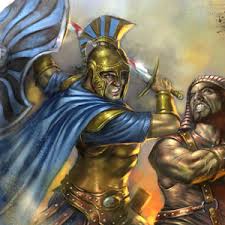by
Damien F. Mackey
“Reading Exodus’ description of Bezalel from a somewhat more historical-critical orientation than that of his predecessors, the early Jewish 20th century scholar Umberto (Rabbi Moshe David) Cassuto, in his commentary to the Book of Exodus, emphasized the similarities between Bezalel’s attributes and descriptions of the Ugaritic, artisan deity Kothar-wa-Ḫasis”.
Introduction
The Ras Shamra (Ugarit) series of tablets has been wrongly dated by historians and chronologists to c. 1550-1200 BC, which is some 500-600 years earlier than the series ought to have been dated. This is a situation common also to the El Amarna [EA] archive, dated to the 1400’s BC instead of to the 800’s BC, approximately. Dr. I. Velikovsky had discussed the chronological anomalies in both cases, in his Ages in Chaos, 1952 and Oedipus and Akhnaton, 1960.
In relation to the Old Testament, we have EA’s pharaoh, Akhnaton, thought to have pre-dated King David by some centuries, and hence the conclusion must be that his Sun Hymn, so like Psalm 104 in many places, must have been the inspiration for the biblical text.
And so we read, for instance (http://www.dubiousdisciple.com/2013/04/psalm-104-the-great-hymn-to-the-aten-2.html):
Today’s topic comes from Douglas A. Knight and Amy Jill Levine’s excellent book, The Meaning of the Bible.
On the wall of a 14th century BCE tomb in Egypt archaeologists found a beautiful hymn to the god Aten. The Aten’s claim to fame is that he is sole God of a monotheistic [sic] belief espoused by Pharaoh Akhenaten (1352-1336) in an era when most Egyptians believed in many gods.
What’s curious about the Great Hymn to the Aten is that it closely mirrors Psalm 104 in our Bible as a song of praise to the creator, though written hundreds of years before any of the Bible [sic]. Psalm 104, of course, is addressed not to the Aten but to YHWH, the god of the Hebrews. Here are some parallels highlighted by Knight and Levine’s book:
O Sole God beside whom there is none! – to Aten
O YHWH my God you are very great. – to YHWH
How many are your deeds … You made the earth as you wished, you alone, All peoples, herds, and flocks. – to Aten
O YHWH, how manifold are your works! In wisdom you have made them all; the earth is full of your creatures. to YHWH
When you set in western lightland, Earth is in darkness as if in death – to Aten
You make darkness, and it is night, when all the animals of the forest come creeping out. – to YHWH
Every lion comes from its den – to Aten
The young lions roar for their prey .. when the sun rises, they withdraw, and lie down in their dens. – to YHWH
When you have dawned they live, When you set they die; – to Aten
When you hide your face, they are dismayed; when you take away their breath, they die – to YHWH
You set every man in his place, You supply their needs; Everyone has his food. – to Aten
These all look to you to give them their food in due season. – to YHWH
The entire land sets out to work – to Aten People go out to their work and to their labor until the evening – to YHWH
The fish in the river dart before you, Your rays are in the midst of the sea. – to Aten
Yonder is the sea, great and wide, creeping things innumerable are there – to YHWH
Birds fly from their nests, Their wings greeting your ka – to Aten
By the streams the birds of the air have their habitation; they sing among the branches – to YHWH
He makes waves on the mountain like the sea, To drench their fields and their towns. – to Aten
You make springs gush forth in the valleys; they flow between the hills … The trees of YHWH are watered abundantly – to YHWH
[End of quote]
This is quite the common view.
Revisionists, however, view it entirely the other way around – that King David had, in fact, pre-dated Akhnaton and EA by more than a century, and so could not have been influenced in his religious ideas by the curious pharaoh. Rather, it was Israel that was culturally influencing the nations of that time.
Ugarit (Ras Shamra)
The same sort of artificial “Dark Age” archaeological gap that the likes of Peter James et al. had discerned in the conventional Hittite history (Centuries of Darkness, 1990), Dr. Velikovsky had already – four decades earlier – shown to have been the case with the Ugarit-Cyprus connection. And so we read (https://www.varchive.org/schorr/ugarit.htm):
In the published volume of Ages in Chaos, Velikovsky made a strong case for challenging Ugarit’s conventional dates.1 He pointed out many 500-year problems in the literary texts uncovered at the site, and shows the difficulty relating to vaulted Cypriote tombs constructed in the style of those from Ugarit but set 500 years later. For those who have not read or were not already convinced by the material presented by Velikovsky for Ras Shamra-Ugarit, perhaps a couple of additional problems will suffice.
Let us again look at the vaulted tombs of Cyprus. Velikovsky has already mentioned some of these, especially the 7th-century example from Trachonas. The island of Cyprus has an “astonishing” number of these tombs2 which divide neatly into two series: those assigned to 1550-1200 B.C., and those beginning in 950 B.C. And continuing for some time.3 The first group of vaulted tombs (at Enkomi) corresponds closely in date and style to the Ugaritic tombs, and the type is thought to have come from Syria to Cyprus.4 The second group of Cypriote tombs corresponds to both the Ugaritic and earlier Cypriote examples, but a 250-year gap separates the inception of the second group from the end of the Bronze Age tombs. More important than the 250-year period when no tombs were built in Syria or Cyprus to connect the later tombs to the earlier ones, is the fact that the earliest tombs of each group (i.e., those of 1550 and 950 B.C.), separated by 600 years, are most similar.5
The Cypriote vaulted tombs from 950-600 B.C. seem to undergo the same development as the Enkomi and Ugaritic tombs with 600 years separating the corresponding phases. It has been postulated that the later tombs somehow copied the earlier Cypriote or Syrian ones, but the tombs presumably copied must have been buried and invisible for some 600 years.6
Similar tombs are found in Jerusalem, Asia Minor, and Urartu of the 9th-7th centuries, and again it is thought that they originated in 9th-7th-century Syro-Phoenicia.7 But the only tombs of this type in that region, notably the ones from Ugarit, are placed centuries earlier.
Leaving behind the regions bordering Syro-Phoenicia, we shall travel briefly to an actual Punic colony. In the 9th or 8th century B.C.,8 a group of Phoenicians sailed to North Africa and founded Carthage. One of the oldest archaeological discoveries from the site is a late 8th-century B.C. built tomb “closely related” to the Ugaritic tombs in architectural plan. 9 It is a “faithful miniature rendering” of the Syrian tombs both in design and, apparently, in arrangements for religious rites.10 It would hardly be surprising for 8th-century Phoenician colonists to bring over a current tomb type and burial customs from their motherland. The only similar tomb type and burial customs that their motherland can produce, however, are put 500 years earlier. By the accepted scheme, the colonists’ ancestors would have been very familiar with these matters, but by the 8th century B.C., the Ugaritic tombs must have been buried over, invisible, and forgotten. 11
How did these tombs of Ugarit serve as models for Cypriots, Israelites, Urartians, Anatolian peoples, and Phoenician colonists, if contemporaneity is denied, and they went out of use and were thus forgotten 500-600 years earlier?
The final items we will examine from Ugarit are a gold bowl and a gold plate, both beautifully decorated. Stratigraphically, they belong shortly before the destruction of the city during the Amarna period, and are thus assigned a date somewhere between 1450-1365 B.C.12 Stylistically, as well, they belong to the Mitannian-Amarna period and show scenes reminiscent of late 18th Dynasty Egypt, notably the time of King Tutankhamen. 13 Both stratigraphically and stylistically, then, a late 18th Dynasty date is necessitated. Since Velikovsky lowers that date by over 500 years, how are the gold bowls affected?
These two pieces are called “remarkable antecedents of the use of the frieze of animals on metal bowls” of Phoenician workmanship, firmly dated to the 9th-7th centuries B.C.14 What is more “remarkable” than the Ugaritic examples’ manufacture and burial over 500 years before the “later” series began, is the subject matter of the two items. Extraordinary conservatism was attributed to the Phoenicians, since the later group faithfully reproduced similar scenes and arrangement of the decoration,15 after a lapse of 500 years.
The chariot scene on the 14th-century gold plate is compared to similar scenes of the 9th-century Neo-Hittites and of the Assyrian King Assurnasirpal II (883-859 B.C.).16 The elongated gallop of the horse is seen to be quite similar to depictions on Assyrian reliefs, but Assyrian influence “is chronologically impossible, all the Assyrian monuments presently known where horses are depicted at gallop being about half a millennium later than our plate” (174). The gold bowl (Fig. 7) with its combination of Aegean, Egyptian, Mesopotamian, and Levantine motifs is “an excellent example of Phoenician syncretism, half a millennium before Phoenicians in the proper sense are known”.17
Surely, it was thought, these golden objects, remarkably foreshadowing by 500 years similar metal bowls and similar scenes, “may be claimed as ancestors of the series of ‘Phoenician’ bowls of the ninth-seventh centuries B.C.”18 How can they be ancestors if they were buried and unseen for 500 years before the later series began, and the art was lost over those 500 years?
If metal bowls reproduced similar scenes in similar arrangements for 500 years, that would indeed be “extraordinary conservatism.” That 9th-7th-century Phoenicians should imitate so closely 14th-century bowls they never saw, after a 500-year gap, is merely “extraordinary.”
When their date is reduced by half a millennium, these bowls fit beautifully into the later series. If one keeps high dates for the Mitannians and the 18th Egyptian Dynasty, then this is yet another mystery to add to our list.
References
- Velikovsky, Ages in Chaos, pp. 179-222.
- Westholm, “Built Tombs in Cyprus,” Opuscula Archaeologica II (1941), p. 30.
- , pp. 32-51.
- , p. 57.
- , pp. 52-53. See also A. Westholm, “Amathus,” in E. Gjerstad, et al.. The Swedish Cyprus Expedition (henceforth SCE) II (Stockholm: 1935), p. 140, and E. Sjöqvist, “Enkomi” SCE I (Stockholm: 1934), pp. 570-73.
- Gjerstad, SCE IV.2 (Stockholm: 1948), p. 239; V. Karageorghis, Excavations in the Necropolis of Salamis I (Salamis, vol. 3) [Nicosia: 1967], p. 123.
- Ussishkin, “The Necropolis from the Time of the Kingdom of Judah at Silwan, Jerusalem,” The Biblical Archaeologist 33 (1970): 45-46.
- The foundation date was disputed in antiquity. Most ancient estimates fell within the range of 846-7 51 B.C. Of particular interest for our purposes is the fact that a number of ancient authors stated that Carthage was founded before the Trojan War.
- C. and C. Picard, The Life and Death of Carthage, trans. from the French by D. Collon (London: 1968), p. 47.
- , p. 52, and see C. Picard, “Installations Cultuelles Retrouveés au Tophet de Salammbo,” Rivista degli Studi Orientali 42 (1967): 189-99.
- Picard, “Installations,” sees close relations between the Ras Shamra and Carthage tombs but recognizes the chronological difficulty. His suggestion, pp. 197-98, that this tomb type came from Cyprus does not help matters. The Carthaginian settlers were primarily Syro-Phoenicians, not Cypriots. Besides, he seems not to realize that the type did not survive in Cyprus from Bronze Age times (contra, p. 197). Like the Carthaginian example, it “came back” after a mysterious chronological gap. Even if we make the Carthage example depend on Cyprus, not Syria, we are still left with the puzzle of how and why the Cypriots copied, yet did not copy, the 600-year extinct tombs of Ras Shamra or Enkomi.
- F. A. Schaeffer, Ugaritica II (Paris: 1949), pp. 5, 47. See H. Frankfort, The Art and Architecture of the Ancient Orient (Baltimore: 1963), p. 150 for their assignment to the Mitannian period, p. 140 for his dates for that period; D. E. Strong, Greek and Roman Gold and Silver Plate (Glasgow: 1966), p. 53.
- Frankfort, Art and Architecture, 150.
- Dikaios, “Fifteen Iron Age Vases,” Report of the Department of Antiquities of Cyprus, 1937-1939 (Nicosia: 1951): 137. 1 72. Schaeffer, Ugaritica II, p. 47.
- Vieyra, Hittite Art, pp. 45-46.
- Schaeffer, Ugaritica II, 22-23: “Une influence de ce coté est chronologique-ment impossible, tous les monuments assyriens actuellement connus où figurent des chevaux au galop étant postérieurs de près d’un demi-millénaire à notre patère.”
- Frankfort, Art and Architecture, 150.
- Strong, Gold and Silver Plate, 53.
[End of quote]
The conventional upside-down chronology for Ugarit has, as with EA, led to the inevitable – but wrong – conclusion that the pagan culture had influenced the supposedly later biblical writings.
The following is a typical example of this mind-set (https://www.britannica.com/place/Ugarit):
Ras Shamra texts and the Bible
Many texts discovered at Ugarit, including the “Legend of Keret,” the “Aqhat Epic” (or “Legend of Danel”), the “Myth of Baal-Aliyan,” and the “Death of Baal,” reveal an Old Canaanite mythology. A tablet names the Ugaritic pantheon with Babylonian equivalents; El, Asherah of the Sea, and Baal were the main deities. These texts not only constitute a literature of high standing and great originality but also have an important bearing on biblical studies. It is now evident that the patriarchal stories in the Hebrew Bible were not merely transmitted orally but were based on written documents of Canaanite origin, the discovery of which at Ugarit has led to a new appraisal of the Hebrew Bible.
[End of quote]
For a complete reversal of this view, though, see my:
Identity of the ‘Daniel’ in Ezekiel 14 and 28
https://www.academia.edu/29786004/Identity_of_the_Daniel_in_Ezekiel_14_and_28
With this new, revised, approach in mind, there may well be need further to re-assess Cassuto’s interpretation – following upon his most helpful comparisons between Bezalel and Ugaritic Kothar-wa-Ḫasis – of “the biblical material as a critique of Canaanite legends and polytheism.[15]”. Rather, I suggest, the Canaanite legends ought to be viewed as later, corrupt, polytheistic versions of the sublime Hebrew originals.
| Baal Bronze figurine, 14th-12th centuries, Ras Shamra (ancient Ugarit) |
Rabbi Jeremy S. Morrison discusses Cassuto’s paralleling of Bezalel and Kothar-wa-Ḫasis in the following terrific article: http://thetorah.com/bezalel-and-the-impotence-of-foreign-deities/
Bezalel Ben Uri and the Impotence of Foreign Deities
Introduction – Bezalel’s Special Attributes
In this week’s parasha, Vayakhel, we encounter one of the Torah’s most enigmatic characters: Bezalel, the artisan and architect who oversees the building of the Tabernacle. Our portion describes Bezalel as filled with divine spirit (ruach elohim), and endowed with wisdom (chochmah), discernment or technical know-how (tevunah) and with knowledge of every kind of work (u’v’da’at u’vchol melachah).[1] The product that Bezalel makes further highlights his special characteristics. As the constructor of the Tabernacle, a dwelling place for Yhwh, Bezalel builds a house that is unique from all other human-built houses. Scholars stress the superlative nature of the Book of Exodus’s description of him: Bezalel has “the gift of originality” and he possesses “all the requisite qualities [of wisdom, discernment and knowledge] in supernatural measure.”[2]
There is indeed something “supernatural” about Bezalel, and the unique and surpassing description of this character provokes compelling questions: Who is Bezalel? Why does Exodus describe him in this manner? And what is his relationship with God?
Human Creativity in the Bible
Biblical Creative Tensions
Within the Bible, creativity is frequently a realm in which God is in conflict with humans. In biblical texts, humans are denied originality [sic]. Knowledge that is generated independently by the human mind, and not installed there by God, “must be at best wrong, at worst possibly antagonistic to God.”[3] The Bible also expresses suspicion regarding human artisanship, particularly metalworking, which often leads to the construction of idols. [4] Bezalel, designated as both a metal worker (Exod. 36:32) and as a thinker “of thoughts or plans” (Exod. 36:35) would seem to embody the “creative tensions” that concern the writers of the Bible. And yet, the description of Bezalel in Vayakhel is not infused with tension; rather, he is presented as an elevated, masterful artisan, skilled in a variety of creative processes, and capable of instructing others.[5]
Yhwh’s Relationship with Bezalel
The absence of tension between God and this particular artisan highlights the special character of their relationship, which is further indicated by the opening verse of the description. As Moses states (35:30) to the Israelites: “See, Yhwh has called by name Bezalel, the son of Uri.”
The description of Bezalel in this week’s portion is a repetition of a previous depiction of Bezalel given by God to Moses. There (Exodus 31: 1- 5), the first person account lends a greater sense of intimacy to the relationship between Yhwh and Bezalel. God declares to Moses (Exod. 31:2), “I have called, by name, Bezalel.” God “calls” someone “by name” in only two other verses in the Bible: when God proclaims God’s own name (in Exod. 33:19) and also when God “calls” Israel “by name” (Isa. 43:1). In each of these contexts, the phrase indicates a distinctive relationship with the individual (Bezalel) or the people (Israel) that God is calling.
The meaning of Bezalel ben Uri’s name –“In the shadow of El, the son of my light”–lends credence to the notion of a special relationship between God and Bezalel. Furthermore, Moses’/God’s declaration (Exod. 35:30/Exod. 31:2) that God has “filled” Bezalel with the “breath/wind/spirit of God” (ruach elohim) places this artisan in a select category of biblical personages upon whom the “spirit/breath/wind of God” comes, including, Joseph, Saul, Ezekiel and Daniel.[6]
The description in Vayakhel, when taken together with the meaning of the name Bezalel, suggests, as Mark S. Smith has written, “an unusual intimacy between God and this otherwise shadowy figure.”[7]
Explaining Bezalel’s Unique Abilities
Since the early centuries of the Common Era, commentators have noted Bezalel’s unique qualities and have raised questions as to his identity. This is clearly reflected, for example, in the later exegetical collection of midrashic collection on the book of Exodus, Shemot Rabbah (40:2), describes Bezalel as having been chosen by God at the beginning of time.[8]
Removing the Supernatural Description
Perhaps out of concern that the superlative nature of the description in Exodus was motivating comparisons between Bezalel and Greco-Roman gods, Josephus, in his Antiquities (1st Century, CE), took pains to recast Bezalel’s commissioning by God and removes God’s calling (kara) of Bezalel:
“[Moses] appointed construction supervisors for the works…their names…were these: Basaelos, son of Ouri of the tribe of Ioudas, grandson of Mariamme the sister of the general and Elibazos, son of Isamachos, of the tribe of Dan (Antiquities 3.104-5).”[9]
Whereas in the Bible, God chooses the architects for the building, in the Antiquities (3.104) Moses selects the architects “in accordance with the instruction of God,” thereby transforming Bezalel from a uniquely gifted craftsman to a humanly chosen member of a team of architects.[10] Perhaps he did so out of concern that the superlative nature of the description in Exodus motivated comparisons between Bezalel and Greco-Roman gods.[11]
Bezalel the Master Sage
The medieval commentator, Abraham ibn Ezra (1089–1164) (Exod. 31:3), notes that Bezalel, had great skill, knew all sorts of hidden mysteries…and understood mathematics, biology, physics, and metaphysics far beyond anyone else of his generation.[12]
According to ibn Ezra, Bezalal was simply a master scholar.
Bezalel the Ancestor of Artisans
The Protestant 20th Century German scholar Martin Noth, in A History of Pentateuchal Traditions, explains the illustrious description of Bezalel by positing that Bezalel was an ancestor of a distinguished family living during the Second Temple Period.[13] Similarly, Ronald E. Clements suggests that Bezalel and Oholiab are ancestors of artisan guilds.[14]
The Israelite Kothar
Reading Exodus’ description of Bezalel from a somewhat more historical-critical orientation than that of his predecessors, the early Jewish 20th century scholar Umberto (Rabbi Moshe David) Cassuto, in his commentary to the Book of Exodus, emphasized the similarities between Bezalel’s attributes and descriptions of the Ugaritic, artisan deity Kothar-wa-Ḫasis. In the Ba(al and Anat cycle, Yamm (the god of the sea) commissions Kothar-wa-Ḫasis to build him a palace. When Ba(al and Anat defeat Yamm, however, Kothar-wa-Ḫasis ends up building the palace for Ba(al. Cassuto sees Bezalal as an alternative to Kothar-wa-Ḫasis, and he interprets the biblical material as a critique of Canaanite legends and polytheism.[15]
The parallels between Bezalel and Kothar wa-Ḫasis should not be taken lightly. Scholars have observed striking similarities between the portrayal of Bezalel and the descriptions of this Ugaritic deity, which are found in the Ugaritic creation myth, the Ba(al and Anat Cycle.[16] Like Bezalel, Kothar–wa-Ḫasis’s skill set encompasses all crafts and he, like, Bezalel, builds a house for a deity, the Canaanite god of creation, Ba(al – Hadad.
Additionally, epithets for Kothar-wa-Ḫasis are analogous to elements of the description of Bezalel.[17] The Ugaritic deity is known as the “Wise One” (Ḫss) (corresponding to chochmah); Kothar wa-Hasis is called “the deft one” (Ugaritic: ḫrš yd) a name that corresponds to Bezalel’s being able to carve or craft (cheresh) stone, wood, or metal.
….
[1] For the complete description of Bezalel in this week’s portion see Ex. 35:30 – 35.
[2] See Benno Jacob, The Second Book of the Bible: Exodus (trans. W.Jacob; Hoboken, NJ: Ktav, 1997), 842; and W. Propp, Exodus 19-40: A New Translation with Introduction and Commentary (The Anchor Bible; New York, Doubleday, 2006), 488.
[3] See Michael Carasik, Theologies of the Mind in Biblical Israel (New York: Peter Lang, 2006), p. 221.
[4] This orientation towards human thinking and creativity is summarized in the Priestly statement: “The Lord saw… how every plan devised by [man’s] mind nothing but evil all the time (Gen. 6:5).” For other examples of the Bible’s pejorative orientation towards human creativity, see Isa. 65:2; Jer. 4:14; Jer. 18:12; Psa. 94:11; and Prov. 19:21.
[5] See Exod. 35:34.
[6] firstshould be rewritten to match the text}}Other biblical characters who experience God’s ruach include: Joseph (Gen. 41:38), Balaam (Num. 24:2), Saul (1 Sam. 10:10; 11:6; 16:5), Ezekiel (Ezek. 11:24), Daniel (5:11,14) and Zechariah (2 Chron. 24:20).
[7] See M. Smith, Kothar wa-Ḫasis, the Ugaritic Craftsman God (Dissertation; Yale University, 1985), 100.
[8] ומה עשה הקדוש ברוך הוא הביא לו ספרו של אדם הראשון והראה לו כל הדורות שהן עתידין לעמוד מבראשית עד תחיית המתים, דור ודור ומלכיו, דור ודור ומנהיגיו, דור ודור ונביאיו, אמר לו כל אחד ואחד התקנתיו מאותה שעה, וכן בצלאל מאותה שעה התקנתיו, הוי ראה קראתי בשם בצלאל.
[9] See Flavius Josephus: Translation and Commentary: Judean Antiquities 1–4, tr. L. Feldman, ed. S. Mason (Leiden: E. J. Brill, 1999), 257–8.
[10] See Steven Fine, “‘See, I Have Called by the Renowned Name of Bezalel, Son of Uri…’: Josephus’ Portrayal of the Biblical ‘Architect’ ,” In The Temple of Jerusalem: From Moses to the Messiah: in honor of Professor Louis H. Feldman, edited by Steven (Leiden: Brill, 2011), p. 29 – 30.
[11] See Fine, p. 30.
[12] והנה בצלאל היה מלא כל חכמה בחשבון, ומדות, וערכים, ומלאכת שמים וחכמת התולדת, וסוד הנשמה. והיה לו יתרון על כל אנשי דורו,
[13] See Martin Noth, A History of Pentateuchal Traditions (trans. Bernhard W. Anderson; Englewood Cliffs: New Jersey, 1972), 188.,
[14] See Ronald E. Clements, Exodus: The Cambridge Bible Commentary (Cambridge: Cambridge University, 1972), 199.
[15] See Umberto Cassuto, A Commentary on the Book of Exodus (trans. I Abrahams; Jerusalem: Magnes Press, 1974), 402.
[16] See KTU 1.1 III; KTU 1.2 IV; KTU 1.4 V-VIII.
[17] See Smith, Kothar wa-Ḫasis, 51-100.
….
